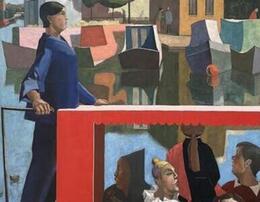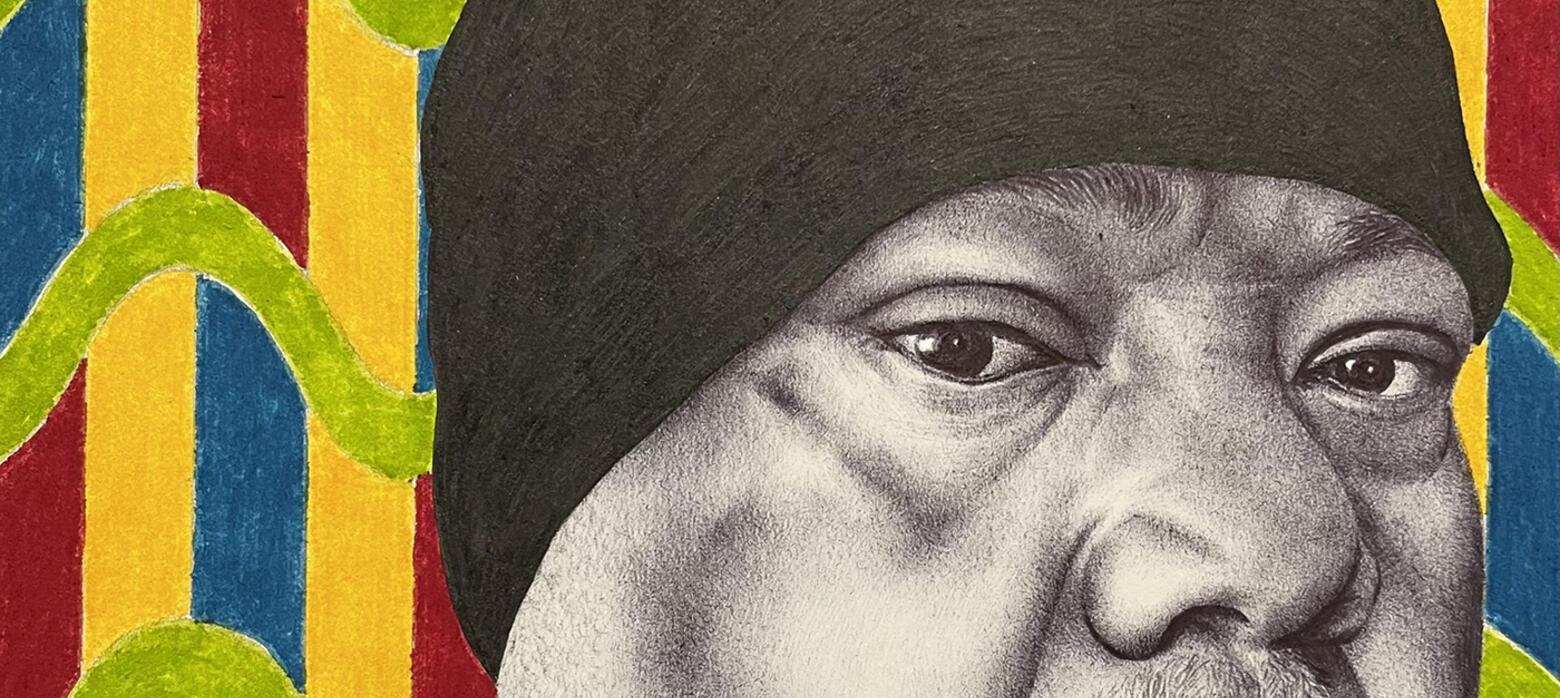Artist Spotlight: Habib Hajallie RBA
/ Royal Society of British Artists
Royal Society of British Artists Bicentennial Exhibition
2 March to 11 March
This exhibition will display an exciting array of works from exceptionally talented artists, such as Habib Hajallie. Habib Hajallie started exhibiting with the RBA Rising Stars (for under 35 year olds) in 2016, but was recently elected as a member of the society and spoke to us about the importance of representation in British portraiture.
Q&A with Habib Hajallie:
You've recently become a member of the RBA, are you able to talk about the process of becoming a member and why you wanted to join?
After successfully exhibiting with the RBA through their annual open calls in 2020 and 2021, I was invited to apply to become a member. I’d previously exhibited with the RBA Rising Stars in 2016, 2018, 2019 and 2022. Mick Davies (RBA president) and his wife, Brenda, have been very supportive of my career since 2016. I recall being initially rejected for the RBA Rising Stars exhibition but then being asked to feature as a ‘wild card’ as the judges felt strongly about including my work in the show.
I was then delighted to be invited to apply to become a full member. I submitted my portfolio, CV and a cover letter to be reviewed by a panel from the RBA. I wanted to become a member as this is one of the most important art societies in the UK with a 200 year legacy. I now have the opportunity to network with more established artists with a depth of experience, which is crucial for me at this point in my career. I also feel I bring something different to the RBA. I'm one of the youngest members and was recently awarded the UK New Artist of The Year award at Saatchi Gallery. It is an immense honour to be a member of the RBA and amongst the proudest achievements of my career.
Can you talk about the erasure of ethnically diverse figures from traditional British Portraiture, and how your work attempts to rectify this?
We assume art shown in galleries or museums tells a complete narrative of a specific moment in time, but know this to be a fallacy. I represent figures that have historically been conspicuously omitted from traditional British portraiture as growing up, I cannot recall seeing many black or brown people within portraits hung in galleries. Thankfully this is changing which is hugely important for future generations. I want people from similar backgrounds to me to feel that they have a voice that is equally as important as anyone else’s.
I am made all too aware on a regular basis that I’m different, due to my pigmentation. I am proud of my Sierra Leonean and Lebanese heritage, and am also aware of how fortunate I am to be born in the UK which has given me opportunities that previous generations of my family didn’t have. Therefore, I feel an onus to champion figures that are marginalised due to the colour of their skin.
From the mid 20th century into the start of the 2000s; artists from ethnically diverse backgrounds were all simply referred to as Black artists, regardless of their ethnicity. This catch-all terminology pigeonholed people of colour who made important contributions towards British art. I read Eddie Chambers’ Black Artists in British Art in my first year of university and felt an immense sense of despair for many artists that came before me from similar ethnic backgrounds. After more research, that despair turned into gratitude for the resilience and fortitude of great pioneering artists that paved the way, enabling a course of less friction for artists like myself.
Though there are still many barriers of entry based on race and ethnicity, the work of artists such as Frank Bowling, Sonia Boyce, Keith Piper, Claudette Johnson and Lumina Himid was crucial. They continued to make significant works during periods where they were not given great enough recognition, an issue that is still being rectified.
I depict motifs that challenge largely accepted revisionist narratives apropos to West African Histories, with semblances of antiquated ideologies at the root of nuanced prejudices that I have experienced. Ultimately, my work catalyses a discourse emboldening individuals that have been labelled as ‘other’ in any manifestation.
Mama Emne, Habib Hajallie RBA, 21 x 15cm, £1,000
How has your Sierra Leonean and Lebanese heritage influenced your work, alongside being born and raised in South East London?
My work is heavily influenced by my Sierra Leonean heritage in particular. My older siblings and parents were born in Freetown, Sierra Leone and I’m the first generation of my family to be born in England. Even though I was born in Bermondsey, London and moved to Kent at the age of 6, I spoke the native language Krio before I could speak English.
Many former British colonies such as Sierra Leone are viewed through a Western lens with a sense of superiority which is a symptom of the colonial gaze. By making works that refer to my Sierra Leonean roots, I strive to show a different and perhaps unseen perspective of the rich history of the country other than blood diamonds or the atrocities of the civil war that may stereotypically come to mind.
The way in which you work primarily in monochromatic ballpoint pen, but offset this with striking bright coloured backgrounds is incredibly powerful. Are you able to talk about these choices and the colourful backgrounds in some of your more recent works?
Specialising in a monochrome medium to celebrate Blackness allows me to somewhat paradoxically show that there is more to an individual than just the colour of their skin. I employ delicate mark-making techniques with precise strokes of the everyday ballpoint pen. I use this relatively modern medium with an almost contradictory classical approach. This process, influenced by sketches from the high renaissance, enables me to celebrate authentic drawing within the digital age.
The deliberate use of vibrant colours in contrast to the monochrome portraits in some of my recent works are directly influenced by traditional Sierra Leonean textiles, prominent within the nation as well as the diaspora.
Big Mo, Habib Hajallie RBA, 21 x 15cm, £1,500
Your family features a lot within your work, can you talk about the process of drawing your family members? Who have you drawn and what is your relationship to the people in ‘Big Mo’ and ‘Mama Emne’?
Placing myself or family members as subjects of my portraits evokes a sense of immediacy, navigating the intersection of my Western upbringing and familial West African culture. I use anecdotal references to portray scenes that are occasionally quasi-surrealist representations as my drawings confront lingering ethnocentrisms embedded within modern Western society.
‘Mama Emne’ is a fineliner pen portrait of my mother, Amina, or Emne in Krio. I’ve drawn an inquisitive yet jovial expression on our family’s matriarch’s face. ‘Big Mo’ is a ballpoint pen portrait of my father, Mohamed, known to his friends as Mo. I played on the prejudicial white gaze depicting my Dad in a pose with a black hat; seen as stereotypically intimidating to some. With sensitive contemplation in his eyes, I hope viewers will discern a greater depth found within the sitter.
It’s important to give those closest to me their flowers whilst they’re still around and to pay homage to those who shaped me, especially being the first generation born in the UK.
Are you able to talk more about your choice of depicting the pianist Fou Ts’ong?
In 2020 I was commissioned by Meta (FKA Facebook Inc) to produce a wallpaper that is now permanently in the London HQ in Kings Cross. Whilst working with their resource groups from various ethnic backgrounds, I produced a series of drawings, called ‘Pioneers’ of 4 individuals from varied backgrounds who overcame adversity and positively contributed towards British society. This original artwork of Chinese born pianist, Fou Ts’ong is part of that series. I will continue to build upon drawing this series, shining a light on figures who have faded into obscurity who should have a greater visibility.
Fou T’song, Habib Hajallie RBA, 42 x 30cm, £4,000
What advice would you give to a young artist from a marginalised group, who rarely sees themselves reflected in the mainstream art world?
Whilst championing global majority ethnic groups is amongst the primary concerns of my practice, you do not have to make work solely about your ethnic identity if that’s not where your passion lies. By making artworks that are firstly authentic to you, you are already making a positive impact regarding the presence of artists from backgrounds that are not visible enough. With the risk of sounding completely cliche, remember as Basquiat once said; “I am not a black artist, I am an artist”.
Advice any young artist could benefit from is to make work you enjoy and that is true to yourself. Don’t be afraid to make work that shows vulnerability with issues you care about. Don’t make work that you think people will like if it isn’t true to your artistic vision. By staying in the game and not quitting you give yourself a chance. Many micro successes lead to macro rewards and consistency is crucial. Regularly check out opportunities, apply thoughtfully to open calls, put your work to the right galleries, maintain your online presence, enjoy the process of making new work and the sales will come.
Perhaps most importantly, look after your mental health. We don’t talk about this enough as artists. It can be an anxiety inducing career, everything is precarious and can be isolating and stressful with the pressures of modern life. Sometimes the most productive thing you can do is to look after yourself!
We really hope you enjoyed learning more about Habib’s work and the importance of diverse representation within portraiture. Make sure you visit the RBA’s Bicentennial exhibition which is on from Thursday 2 March until Saturday 11 March, to see Habib’s work amongst 400+ other incredible pieces.

